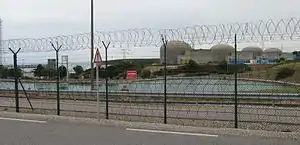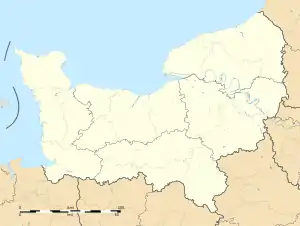Paluel | |
|---|---|
 | |
.svg.png.webp) Coat of arms | |
Location of Paluel | |
 Paluel  Paluel | |
| Coordinates: 49°50′01″N 0°37′44″E / 49.8336°N 0.6289°E | |
| Country | France |
| Region | Normandy |
| Department | Seine-Maritime |
| Arrondissement | Dieppe |
| Canton | Saint-Valery-en-Caux |
| Intercommunality | CC Côte d'Albâtre |
| Government | |
| • Mayor (2020–2026) | Didier Gaston[1] |
| Area 1 | 10.87 km2 (4.20 sq mi) |
| Population | 395 |
| • Density | 36/km2 (94/sq mi) |
| Time zone | UTC+01:00 (CET) |
| • Summer (DST) | UTC+02:00 (CEST) |
| INSEE/Postal code | 76493 /76450 |
| Elevation | 0–96 m (0–315 ft) (avg. 9 m or 30 ft) |
| 1 French Land Register data, which excludes lakes, ponds, glaciers > 1 km2 (0.386 sq mi or 247 acres) and river estuaries. | |
Paluel (French pronunciation: [palɥɛl]) is a commune in the Seine-Maritime department in the Normandy region in northern France.
Geography
A village of farming and light industry situated by the banks of the river Durdent in the Pays de Caux at the junction of the D10, D68 and the D79 roads, some 20 miles (32 km) southwest of Dieppe.
History
The village owes its name to the marshes (in Latin "Palus"), in the lower valley of the Durdent.
A Roman mosaic was excavated in 1849 at a place known as the Rosy.
A church has existed here from 988, under the jurisdiction of the abbey at Fécamp.
The manor of Janville was given to the seigneurs of Paluel by Henri III in 1582.
There was a leper colony here until 1695.
The commune had 638 inhabitants in 1876.
The United States "Lucky Strike" army camp counted 300,000 inhabitants after the offensive against Germany during 1944/45.
In 1977, EDF, the French electricity company, built a nuclear power station, with 4 reactors of 1300MW each. It covers 200 hectares (490 acres) of land within the commune.
Population
| Year | Pop. | ±% p.a. |
|---|---|---|
| 1968 | 389 | — |
| 1975 | 364 | −0.94% |
| 1982 | 443 | +2.85% |
| 1990 | 383 | −1.80% |
| 1999 | 416 | +0.92% |
| 2007 | 454 | +1.10% |
| 2012 | 457 | +0.13% |
| 2017 | 432 | −1.12% |
| Source: INSEE[3] | ||
Places of interest
- The nuclear power station on the coast at Conteville.
- The seventeenth-century château de Janville, with its dovecote and park.
- The two 18th-century châteaux at Bertheauville and Conteville
- The chapel of Notre-Dame at Janville, dating from the thirteenth century.
- The church of St. Pierre, dating from the twelfth century.
- The church of St. Martin, dating from the thirteenth century.
- A sixteenth-century stone cross.
See also
References
- ↑ "Répertoire national des élus: les maires" (in French). data.gouv.fr, Plateforme ouverte des données publiques françaises. 13 September 2022.
- ↑ "Populations légales 2021". The National Institute of Statistics and Economic Studies. 28 December 2023.
- ↑ Population en historique depuis 1968, INSEE